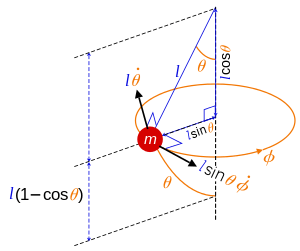Spherical pendulum

Spherical pendulum: angles and velocities.
In physics, a spherical pendulum is a higher dimensional analogue of the pendulum. It consists of a mass m moving without friction on the surface of a sphere. The only forces acting on the mass are the reaction from the sphere and gravity.
Owing to the spherical geometry of the problem, spherical coordinates are used to describe the position of the mass in terms of (r, θ, φ), where r is fixed. In what follows l is the constant length of the pendulum, so r = l.
Lagrangian mechanics
Main article: Lagrangian mechanics
The Lagrangian is [1]
The Euler–Lagrange equations give :
and
showing that angular momentum is conserved.
Hamiltonian mechanics
Main article: Hamiltonian mechanics
The Hamiltonian is
where
and
See also
References
This article is issued from Wikipedia - version of the 5/8/2016. The text is available under the Creative Commons Attribution/Share Alike but additional terms may apply for the media files.